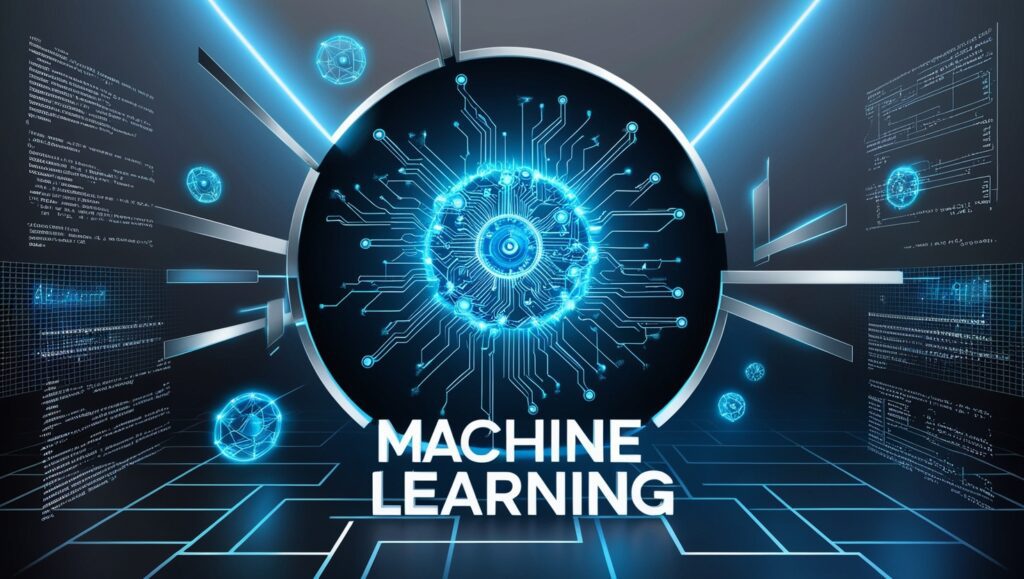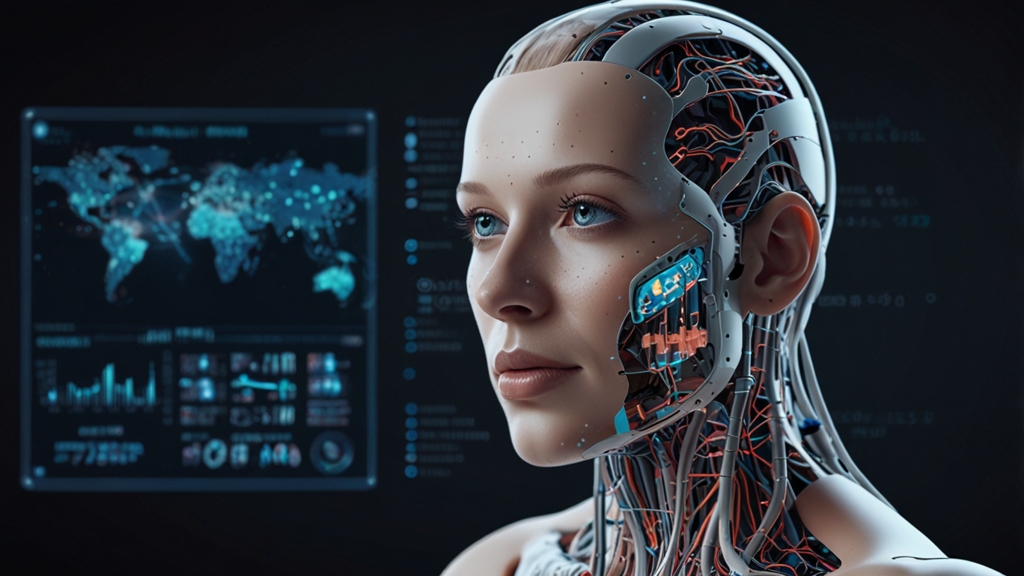Machine Learning in 2025: The Future of Intelligent Computing
1. Introduction
In today’s fast-paced digital era, Machine Learning (ML) has emerged as one of the most influential technologies driving automation, innovation, and intelligent decision-making. Machine learning is a subset of artificial intelligence (AI) that enables computers to learn from data without explicit programming. Over the past few decades, ML has evolved from a theoretical concept into a practical tool that powers a wide range of applications, from recommendation systems to self-driving cars.

The rise of big data, increased computational power, and advanced algorithms has fueled the growth of machine learning, making it an indispensable part of industries worldwide. As businesses and researchers continue to explore its potential, ML is set to redefine the future of technology.
2. How Machine Learning Works
At its core, machine learning revolves around data-driven decision-making. Traditional programming involves writing explicit instructions for computers, whereas ML enables systems to learn from past experiences and improve over time. The working mechanism of ML includes:
- Data Collection: Gathering structured or unstructured data from various sources.
- Data Preprocessing: Cleaning and organizing data to make it suitable for training.
- Model Training: Feeding data into algorithms to identify patterns and relationships.
- Testing & Validation: Evaluating model performance on unseen data.
- Deployment: Integrating the trained model into real-world applications.
- Continuous Learning: Updating and improving the model as more data becomes available.
Machine learning operates on mathematical models that analyze data, identify trends, and make predictions or classifications with minimal human intervention.
3. Types of Machine Learning

Machine learning (ML) can be broadly categorized into three main types: Supervised Learning, Unsupervised Learning, and Reinforcement Learning. Each type has distinct characteristics, learning methods, and applications in various industries.
A. Supervised Learning
Supervised learning is one of the most commonly used machine learning paradigms. In this type of learning, the algorithm is trained on a labeled dataset, meaning that each input data point is associated with the correct output. The model learns to map inputs to the desired outputs by minimizing the difference between predictions and actual values.
How It Works:
The algorithm is fed with a dataset that contains input-output pairs.
It learns the relationship between the input variables (features) and the output (target variable).
Once trained, the model can predict outcomes for new, unseen data.
It uses techniques such as classification and regression to make predictions.
Examples of Supervised Learning:
Email Spam Detection: The system learns to classify emails as “spam” or “not spam” based on historical labeled data. Features such as keywords, sender information, and links are used to make predictions.
Image Recognition: AI models can classify images by identifying patterns and features in labeled datasets. For example, distinguishing between cats and dogs in photos.
Credit Risk Assessment in Banking: Banks use supervised learning models to predict whether a loan applicant is a high or low credit risk based on factors such as credit history, income, and previous loan repayment records.
Algorithms Used in Supervised Learning:
Linear Regression: Predicts continuous values (e.g., house prices based on size and location).
Logistic Regression: Used for binary classification problems (e.g., predicting whether a customer will buy a product or not).
Decision Trees & Random Forest: Used in classification and regression tasks (e.g., fraud detection, medical diagnosis).
Support Vector Machines (SVM): Used for pattern recognition and classification tasks.
Neural Networks: Used for complex pattern recognition problems like image processing and speech recognition.
B. Unsupervised Learning
Unlike supervised learning, unsupervised learning works with unlabeled data, meaning there are no predefined output labels. Instead, the algorithm must discover hidden structures, patterns, or relationships in the data on its own.
How It Works:
The algorithm processes large volumes of unlabeled data.
It identifies patterns, similarities, and clusters without prior training.
This technique is often used for data exploration, segmentation, and anomaly detection.
Examples of Unsupervised Learning:
Customer Segmentation for Targeted Marketing: Businesses use clustering algorithms to group customers based on purchasing behavior, demographics, and preferences to create personalized marketing strategies.
Anomaly Detection in Cybersecurity: Security systems use unsupervised learning to detect unusual patterns in network traffic, helping identify cyber threats and fraud.
Product Recommendation Systems: E-commerce platforms and streaming services analyze users’ browsing and purchasing history to recommend products, movies, or music.
Common Algorithms Used in Unsupervised Learning:
K-Means Clustering: Groups similar data points together (e.g., segmenting customers based on buying behavior).
Hierarchical Clustering: Builds a hierarchy of clusters, useful in medical imaging and genetics.
Principal Component Analysis (PCA): Reduces the dimensionality of data while retaining important information (used in image compression and bioinformatics).
Autoencoders: Neural networks used for feature extraction and anomaly detection.
C. Reinforcement Learning (RL)
Reinforcement learning is a reward-based machine learning approach where an agent learns to make decisions by interacting with an environment. The agent receives feedback in the form of rewards or penalties based on its actions, which helps it optimize its strategy over time.
How It Works:
The RL model (agent) interacts with an environment by taking actions.
It receives feedback (reward or penalty) based on the effectiveness of the action.
Over time, it learns an optimal strategy (policy) that maximizes the total reward.
RL is particularly useful in situations requiring sequential decision-making.
Examples of Reinforcement Learning:
Game AI (e.g., AlphaGo and Chess Engines): AI models like AlphaGo and DeepMind’s MuZero have mastered complex board games, defeating human champions by learning optimal moves through self-play.
Robotics and Autonomous Vehicles: Robots and self-driving cars use RL to navigate environments, avoid obstacles, and make real-time decisions.
Stock Market Trading Bots: Reinforcement learning is used in financial markets to develop AI-powered trading strategies that maximize returns based on market fluctuations.
Common Algorithms Used in Reinforcement Learning:
Q-Learning: A value-based algorithm that helps an agent learn the best actions to take.
Deep Q Networks (DQN): A deep learning-based RL technique used in gaming and robotics.
Policy Gradient Methods: Directly optimize the policy function to achieve better performance in continuous decision-making tasks.
Comparison of the Three Types of Machine Learning
Feature Supervised Learning Unsupervised Learning Reinforcement Learning
Data Type Labeled Data Unlabeled Data Reward-based System
Objective Predict outputs based on past data Identify hidden patterns Learn optimal actions through feedback
Examples Email spam detection, Image recognition, Fraud detection Customer segmentation, Anomaly detection, Product recommendations Game AI, Robotics, Stock trading
Common Algorithms Linear Regression, Decision Trees, Neural Networks K-Means, PCA, Hierarchical Clustering Q-Learning, Deep Q Networks
4. Key Algorithms in Machine Learning
Several algorithms drive machine learning applications, including:
- Linear Regression: Used for predicting numerical values based on historical data.
- Logistic Regression: Used for binary classification problems, such as spam detection.
- Decision Trees & Random Forest: Decision trees help in classification tasks, while random forests enhance accuracy by using multiple trees.
- Support Vector Machines (SVM): Used for classification by finding the optimal decision boundary.
- Neural Networks & Deep Learning: Mimic human brain neurons to process complex patterns and large datasets.
- K-Means Clustering: Groups similar data points into clusters for unsupervised learning.
- Principal Component Analysis (PCA): Reduces dimensionality while preserving essential features of the dataset.
5. Applications of Machine Learning
Machine learning (ML) has transformed numerous industries by enabling intelligent automation, improving decision-making, and providing deep data-driven insights. From healthcare and finance to autonomous vehicles and cybersecurity, ML has paved the way for significant advancements. Below are some of the most impactful applications of machine learning across various sectors.
A. Healthcare
The healthcare industry has embraced machine learning to improve diagnosis, treatment, and overall patient care. ML models help in detecting diseases early, predicting patient outcomes, and personalizing treatments based on individual data.
Key Applications:
Disease Prediction and Early Diagnosis
Machine learning algorithms analyze medical data, such as X-rays, MRIs, and genetic information, to detect diseases like cancer, Alzheimer’s, and diabetes at an early stage.
Example: IBM Watson Health uses ML to assist doctors in diagnosing diseases more accurately.
Personalized Treatment Plans
ML helps in precision medicine by tailoring treatments based on an individual’s genetics, medical history, and response to previous treatments.
Example: AI-driven platforms suggest customized chemotherapy plans for cancer patients, improving recovery chances.
Drug Discovery and Development
Traditional drug development is time-consuming and expensive. ML accelerates drug discovery by analyzing biological data, predicting drug interactions, and identifying new drug candidates.
Example: DeepMind’s AlphaFold uses AI to predict protein structures, helping in faster drug design.
B. Finance
Machine learning is widely used in the financial sector for fraud detection, algorithmic trading, and risk assessment. ML models analyze vast amounts of financial data to identify anomalies, detect fraudulent activities, and automate trading strategies.
Key Applications:
Fraud Detection in Banking Transactions
ML algorithms analyze transaction patterns to detect suspicious activities and fraudulent transactions in real-time.
Example: Mastercard and Visa use ML-based fraud detection systems to flag unusual transactions.
Algorithmic Trading for Stock Market Analysis
ML models analyze historical market data, news articles, and social media trends to predict stock price movements and execute trades automatically.
Example: Hedge funds use AI-driven trading bots for high-frequency trading (HFT).
Risk Assessment for Loans and Insurance
ML predicts a borrower’s creditworthiness based on financial history, employment records, and spending behavior.
Example: Banks use AI-powered models to assess loan approvals, mortgage rates, and insurance risk levels.
C. E-commerce
Machine learning is transforming e-commerce by improving customer experience, increasing sales, and optimizing business operations.
Key Applications:
Personalized Product Recommendations
ML algorithms analyze a user’s browsing history, past purchases, and preferences to recommend products that match their interests.
Example: Amazon, Netflix, and Spotify use AI-driven recommendation engines to suggest products, movies, and music.
Chatbots for Customer Support
AI-powered chatbots provide instant assistance by answering queries, resolving complaints, and guiding users through shopping processes.
Example: ChatGPT-powered virtual assistants are used in e-commerce websites for customer interactions.
Price Optimization Strategies
ML models analyze market trends, competitor prices, and demand fluctuations to set dynamic pricing strategies that maximize profits.
Example: Airlines, ride-hailing apps (Uber), and hotel booking platforms use AI for price optimization.
D. Autonomous Vehicles
Machine learning plays a crucial role in self-driving technology, enhancing safety, navigation, and real-time decision-making.
Key Applications:
Self-Driving Cars (e.g., Tesla Autopilot)
ML models process data from cameras, LiDAR, and sensors to detect obstacles, recognize traffic signs, and make driving decisions.
Example: Tesla’s Autopilot and Waymo’s self-driving cars use AI for autonomous driving.
AI-Driven Traffic Management
ML-powered traffic systems analyze congestion patterns, optimize traffic lights, and suggest alternate routes to reduce travel time.
Example: Smart cities use AI traffic control systems to improve urban mobility.
Smart Navigation Systems
AI-powered navigation apps like Google Maps and Waze analyze real-time traffic data, weather conditions, and road closures to optimize routes.
E. Cybersecurity
With the increasing number of cyber threats, machine learning has become an essential tool for threat detection, malware identification, and security automation.
Key Applications:
AI-Based Threat Detection and Prevention
ML models analyze network traffic, user behavior, and login patterns to detect cyberattacks such as DDoS attacks, phishing attempts, and ransomware infections.
Example: Darktrace and IBM Security use AI to monitor and mitigate cyber threats.
Identifying Malicious Activities and Cyberattacks
ML algorithms detect anomalies in emails, files, and system activities to flag suspicious behavior.
Example: AI-driven email security tools detect and block phishing emails and malicious attachments.
Automating Security Protocols
AI-powered security systems automatically update firewalls, detect vulnerabilities, and respond to threats without human intervention.
Example: SIEM (Security Information and Event Management) systems use ML for automated security monitoring.
6. Machine Learning vs. AI vs. Deep Learning
While often used interchangeably, Machine Learning, Artificial Intelligence, and Deep Learning are distinct concepts:
- Artificial Intelligence (AI): A broad field that encompasses machine learning and aims to create machines that can mimic human intelligence.
- Machine Learning (ML): A subset of AI that allows systems to learn and improve from data.
- Deep Learning (DL): A subset of ML that utilizes deep neural networks for complex problem-solving (e.g., speech recognition, facial recognition).
Deep learning is particularly powerful in handling large-scale unstructured data such as images, text, and videos.
7. Challenges in Machine Learning
Despite its vast potential, machine learning faces several challenges:
- Data Quality: ML models require high-quality, relevant data to function effectively.
- Overfitting & Underfitting: Overfitting occurs when a model learns too much noise, while underfitting happens when the model fails to capture patterns.
- Interpretability: Many ML models, especially deep learning, operate as “black boxes,” making it difficult to understand their decisions.
- Ethical Concerns: Bias in training data can lead to unfair decisions (e.g., biased hiring algorithms).
- Security Risks: ML systems can be vulnerable to adversarial attacks that manipulate data to deceive models.
8. Future of Machine Learning
Machine learning is rapidly evolving, with several emerging trends shaping its future:
- Automated Machine Learning (AutoML): Reducing manual effort in model selection and hyperparameter tuning.
- Explainable AI (XAI): Improving transparency in AI decision-making.
- Federated Learning: Decentralized learning that enhances privacy and data security.
- Integration with IoT & Cloud Computing: ML models are increasingly deployed on edge devices and cloud platforms for real-time analytics.
- Quantum Machine Learning: Combining quantum computing with ML to solve complex problems faster.
9. How to Get Started with Machine Learning
If you’re looking to dive into machine learning, here’s a step-by-step guide:
Prerequisites:
- Strong foundation in Mathematics & Statistics (Linear Algebra, Probability, Calculus)
- Proficiency in Programming (Python, R, or Java)
- Understanding of Data Science & Analytics
Popular ML Frameworks & Libraries:
- TensorFlow & Keras – Deep learning and neural networks
- PyTorch – Flexible framework for AI research
- Scikit-Learn – Standard ML algorithms
- Pandas & NumPy – Data manipulation tools
Best Resources to Learn ML:
- Online Courses: Coursera, Udacity, edX
- Books: ‘Hands-on Machine Learning’ by Aurélien Géron
- YouTube Channels: Sentdex, Data School
10. Conclusion
Machine learning is undoubtedly the cornerstone of modern technological advancements. From healthcare to cybersecurity, its applications are endless, making it a critical field for businesses and researchers. While ML comes with challenges, continuous advancements in algorithms and computing power are pushing the boundaries of what’s possible.
With the right knowledge and tools, anyone can embark on a journey to master machine learning and contribute to the AI-driven future.









